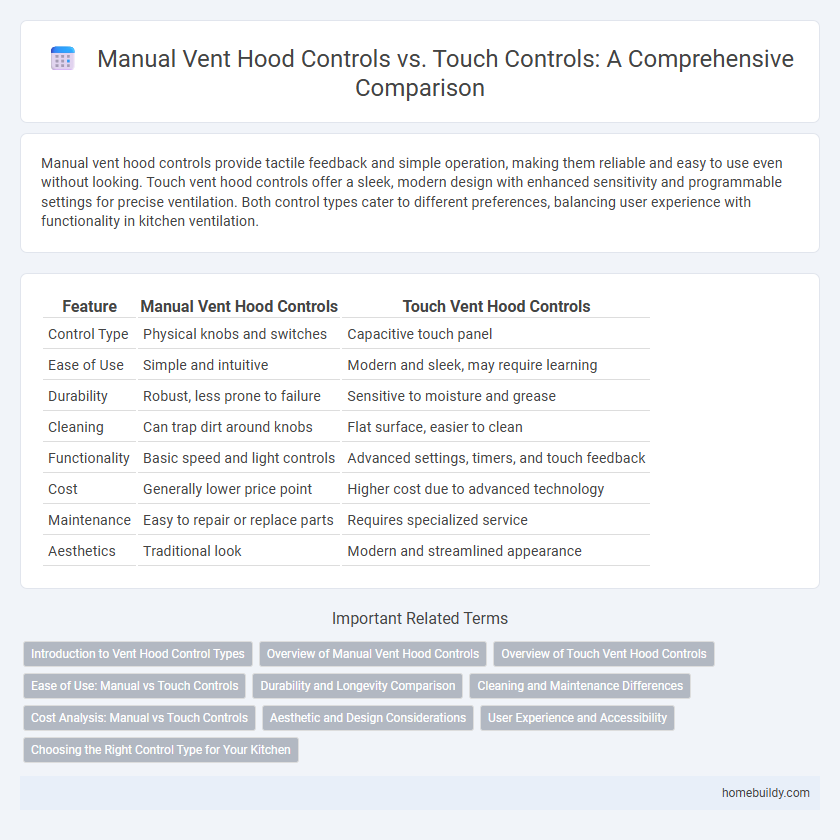Manual vent hood controls provide tactile feedback and simple operation, making them reliable and easy to use even without looking. Touch vent hood controls offer a sleek, modern design with enhanced sensitivity and programmable settings for precise ventilation. Both control types cater to different preferences, balancing user experience with functionality in kitchen ventilation.
Table of Comparison
| Feature | Manual Vent Hood Controls | Touch Vent Hood Controls |
|---|---|---|
| Control Type | Physical knobs and switches | Capacitive touch panel |
| Ease of Use | Simple and intuitive | Modern and sleek, may require learning |
| Durability | Robust, less prone to failure | Sensitive to moisture and grease |
| Cleaning | Can trap dirt around knobs | Flat surface, easier to clean |
| Functionality | Basic speed and light controls | Advanced settings, timers, and touch feedback |
| Cost | Generally lower price point | Higher cost due to advanced technology |
| Maintenance | Easy to repair or replace parts | Requires specialized service |
| Aesthetics | Traditional look | Modern and streamlined appearance |
Introduction to Vent Hood Control Types
Manual vent hood controls use physical knobs or buttons to operate fan speed and lighting, offering straightforward and reliable functionality preferred for their tactile feedback. Touch vent hood controls employ capacitive or membrane touch sensors, providing sleek aesthetics and easier cleaning, often integrated with digital displays for precise adjustments. Choosing between manual and touch controls depends on user preference for durability and simplicity versus modern design and convenience.
Overview of Manual Vent Hood Controls
Manual vent hood controls offer a straightforward design featuring physical knobs or switches that provide tactile feedback and precise airflow adjustment. These controls ensure reliable operation without dependency on electronic components, making them durable and easy to repair in various kitchen environments. Manual vent hood controls typically include multiple fan speeds and light settings, allowing customized ventilation tailored to cooking intensity and room ambiance.
Overview of Touch Vent Hood Controls
Touch vent hood controls offer a sleek, modern interface that enhances user convenience and precise operation compared to traditional manual controls. These controls typically feature capacitive touch sensors and LED indicators, providing intuitive settings for fan speeds, lighting, and timer functions. Advanced models may include smart integration with home automation systems, improving efficiency and ease of use in kitchen ventilation.
Ease of Use: Manual vs Touch Controls
Manual vent hood controls offer straightforward operation with tactile buttons or knobs, allowing users to easily adjust fan speed and lighting without needing to navigate complex menus. Touch vent hood controls provide a sleek interface with responsive sensitivity, enabling quick changes and modern features like timer settings, but may require more precision and can be less intuitive for some users. Ease of use often depends on personal preference, with manual controls favored for simplicity and touch controls for advanced functionality and a contemporary look.
Durability and Longevity Comparison
Manual vent hood controls typically offer greater durability and longevity due to their simple mechanical components that withstand frequent use and exposure to kitchen heat and moisture. Touch vent hood controls, while providing a modern, sleek interface, may be more prone to wear from repeated contact and are susceptible to malfunction from grease and moisture buildup. Choosing manual controls can enhance the vent hood's lifespan and reduce maintenance needs in busy kitchen environments.
Cleaning and Maintenance Differences
Manual vent hood controls typically feature physical buttons or knobs that can accumulate grease and grime, requiring regular cleaning with a damp cloth and mild detergent to maintain functionality. Touch vent hood controls, while offering a sleek, modern interface, are more sensitive to fingerprints and smudges and often need specialized screen cleaners to avoid damage and preserve responsiveness. Both control types demand routine maintenance, but touch controls generally require more careful handling to prevent wear and ensure long-term durability.
Cost Analysis: Manual vs Touch Controls
Manual vent hood controls typically have a lower upfront cost, making them a budget-friendly option for homeowners and businesses. Touch vent hood controls, while more expensive initially, often provide enhanced durability and ease of cleaning, which can reduce long-term maintenance expenses. Evaluating energy efficiency and potential repair costs is crucial to understanding the overall value between manual and touch control vent hoods.
Aesthetic and Design Considerations
Manual vent hood controls offer a traditional aesthetic with physical knobs and buttons that complement classic kitchen designs, providing tactile feedback and ease of use. Touch vent hood controls feature a sleek, modern appearance with a smooth glass or stainless steel surface, enhancing minimalist and contemporary kitchen styles. While touch controls contribute to a streamlined look, manual controls may better suit kitchens prioritizing vintage or industrial design elements.
User Experience and Accessibility
Manual vent hood controls provide tactile feedback that enhances user experience through precise adjustments and ease of use for individuals with limited dexterity, making them highly accessible. Touch vent hood controls offer a sleek design and easy cleaning but may present challenges for users with wet or gloved hands, potentially reducing accessibility. Considering user experience and accessibility, manual controls typically deliver greater reliability and inclusive functionality compared to touch-sensitive alternatives.
Choosing the Right Control Type for Your Kitchen
Manual vent hood controls offer tactile feedback and reliability with simple knobs or buttons, ideal for users who prefer straightforward operation and durability. Touch vent hood controls provide a modern, sleek design with easy-to-clean surfaces and precise adjustments, suitable for contemporary kitchens emphasizing aesthetics and convenience. Selecting the right control type depends on your kitchen's style, user preference for ease of use, and desired maintenance level.
Manual vent hood controls vs Touch vent hood controls Infographic

 homebuildy.com
homebuildy.com